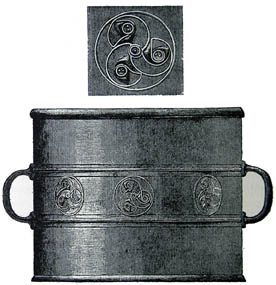Victoria
County History of Kent Vol. 3
1932
Romano-British
Kent - Introduction - Page 5
|
all classes, and the educated classes outside the
towns, seem to have used Latin. At Silchester, for instance, we meet
on broken tiles or potsherds various brief scribblings in the Latin
tongue which are the work of labourers or of domestic servants,
while similar scribblings in Celtic are wholly absent. We cannot
help concluding that the labourers and servants spoke and wrote
Latin.
On the side of material civilization the Roman
influence reigned no less supreme. Before the Roman period there had
existed in Britain a Late Celtic art of much merit, working
especially in metal, and distinguished for its fantastic use of
plant and animal forms, its love for the geometrical ornament known
as the ‘returning spiral,’ and its enamelling (fig. 2). It
was a true art. Though incapable of portraying the human figure, and
though confined almost entirely to the decoration of useful
objects—collars, brooches, sword-handles, shields—it exhibits a
lively originality in dealing with its own conventions, a delicate,
if sometimes |
|
rather quaint sense of beauty, and a genuine
delight in the ornamentation of every detail, which are rare in the
world before the Middle Ages. This art, though it flared up for a
last brilliant moment in the half-century following the conquest,
was ultimately almost extinguished by the Roman. Occasionally,
indeed, as in the potteries of the New Forest and of Castor, near
Peterborough, its influence can still be traced in the third or
fourth centuries. But even these survivals became modified by Roman
influences, and whenever they are modified—for instance, when the
local potters admit scenes from classical mythology into their
repertory—they lose their vigour. In general, the Late Celtic art
suffered the fate which befalls |

Fig. 2 Tankard from Elvenden (Co.
Suffolk) showing Late Celtic Art
|
|
every picturesque semi-civilized art which is
confronted by an organized and coherent culture.
Almost every feature in Romano-British life was Roman.
The commonest good pottery, the red sealing-wax-like ware called
Samian or Terra Sigillata, copied from an Italian original, was made
in Gaul or Germany, and was purely classical in outline and ornament.
The mosaics and frescoes which adorned the houses and public
buildings, the hypocausts which warmed them, the bathrooms which added
to their luxury, were all alike borrowed from Italy. Nor are these
importations confined to the mansions of the |
Previous
Page Page 5
Next Page
Back
to Introduction
Contents
Page
This website is constructed
by enthusiastic amateurs. Any errors noticed by other researchers will be gratefully received so
that we can amend our pages to give as accurate a record as
possible. Please send details to localhistory@tedconnell.org.uk
|